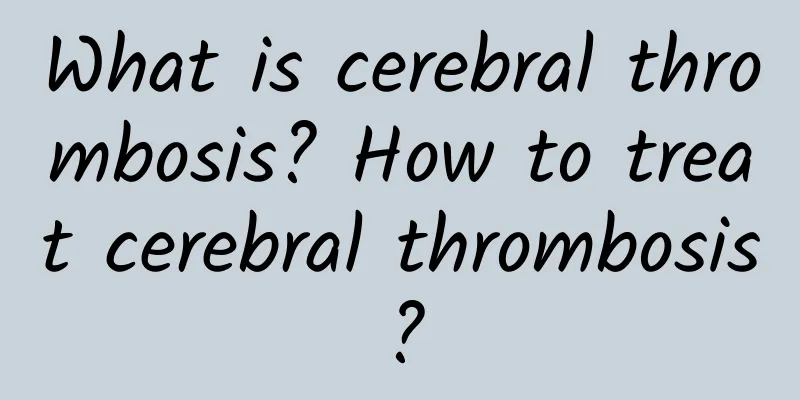What is cerebral thrombosis? How to treat cerebral thrombosis?

|
Cerebral thrombosis is a common type of cerebral infarction. Generally speaking, after a cerebral thrombosis occurs, the patient may become a vegetative state. Therefore, the understanding and treatment of cerebral thrombosis must be carried out in a timely manner. What is cerebral thrombosis? Cerebral thrombosis is the most common type of cerebral infarction. It is caused by atherosclerosis of the main trunk or cortical branches of the cerebral arteries, which leads to vascular thickening, lumen stenosis and occlusion, and thrombosis, resulting in reduced local blood flow or interruption of blood supply to the brain. Ischemia and hypoxia of the brain tissue lead to softening and necrosis, and focal neurological symptoms. Treatment of cerebral thrombosis: 1. Medication Principles of acute drug treatment. (1) Ultra-early treatment should first raise the public's awareness of stroke emergencies and first aid and make them understand the importance and necessity of ultra-early treatment. See a doctor immediately after the onset of the disease. If there are no contraindications, try to provide thrombolytic therapy within the 3-6 hour treatment window, reduce brain metabolism, control brain edema, protect brain cells, and save the ischemic penumbra. (2) Individualized treatment: The most appropriate treatment should be taken according to the patient's age, ischemic stroke type, severity of the disease, and underlying diseases; (3) Prevent and treat complications such as infection, cerebrocardiac syndrome, hypothalamic injury, post-stroke anxiety or depression, syndrome of inappropriate antidiuretic hormone secretion, and multiple organ failure; (4) Holistic treatment includes supportive therapy, symptomatic treatment and early rehabilitation treatment; timely preventive intervention is taken for stroke risk factors such as hypertension, diabetes and heart disease to reduce the recurrence rate and lower the disability rate. 2. Surgical treatment For patients with large supratentorial cerebral infarction with severe cerebral edema, space-occupying effect, and signs of brain herniation, decompressive craniotomy can be performed. For patients whose condition worsens due to cerebellar infarction and brain stem compression, aspiration of the infarcted cerebellar tissue and posterior cranial fossa decompression can be saved. 3. Rehabilitation It should be carried out early and follow the principle of individualization to formulate short-term and long-term treatment plans, select treatment methods in stages and according to local conditions, provide patients with targeted physical and skill training to reduce the disability rate, promote neurological function recovery, improve quality of life and reintegrate into society. |
<<: There are three common methods for treating brain atrophy.
>>: How to treat inguinal hernia effectively
Recommend
Poor liver function can actually affect the eyes.
The liver is a relatively important organ for the...
Symptoms of cerebral infarction
Cerebral infarction is a disease with a high inci...
Can cupping be done continuously?
In the field of traditional Chinese medicine, it ...
How to treat neuralgia caused by herpes zoster
Shingles is a relatively common skin disease, whi...
What is the treatment for tinnitus and deafness in the elderly?
Tinnitus and deafness are common diseases in the ...
Lumbar interspinous ligament edema
Edema is a common occurrence in the human body, b...
What is the medicinal value of buckwheat?
Buckwheat is an item that everyone is familiar wi...
Living in the basement made me sick
Now housing prices are getting higher and higher,...
The most effective medicine for preventing asthma
Clinical diagnosis: recurrent wheezing and dyspne...
Does underarm breast need treatment?
Do accessory breasts under the arms need treatmen...
Is pulmonary edema contagious? Timely treatment is the most important
Pulmonary edema is mostly acute, and coughing is ...
Do babies need to drink water during confinement?
Women have the habit of sitting in confinement af...
Pueraria lobata soft capsule
Now the incidence rate of cardiovascular and cere...
Why are my eyes so itchy after double eyelid surgery?
After having double eyelid surgery, many people w...
Symptoms of sexual dysfunction in older men
As people age, the functions of their various org...









